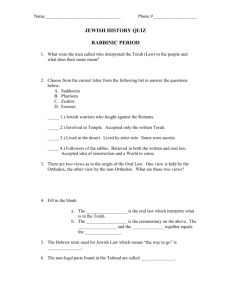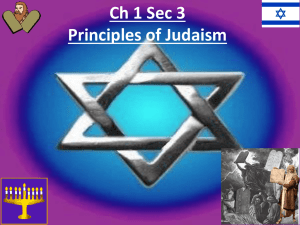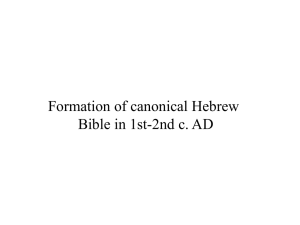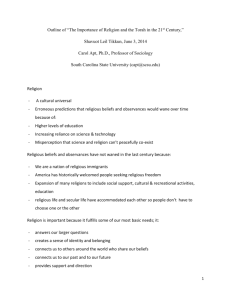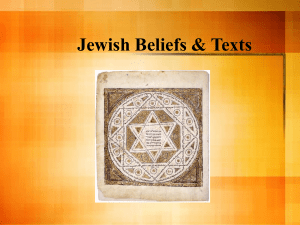WORLD RELIGION
advertisement
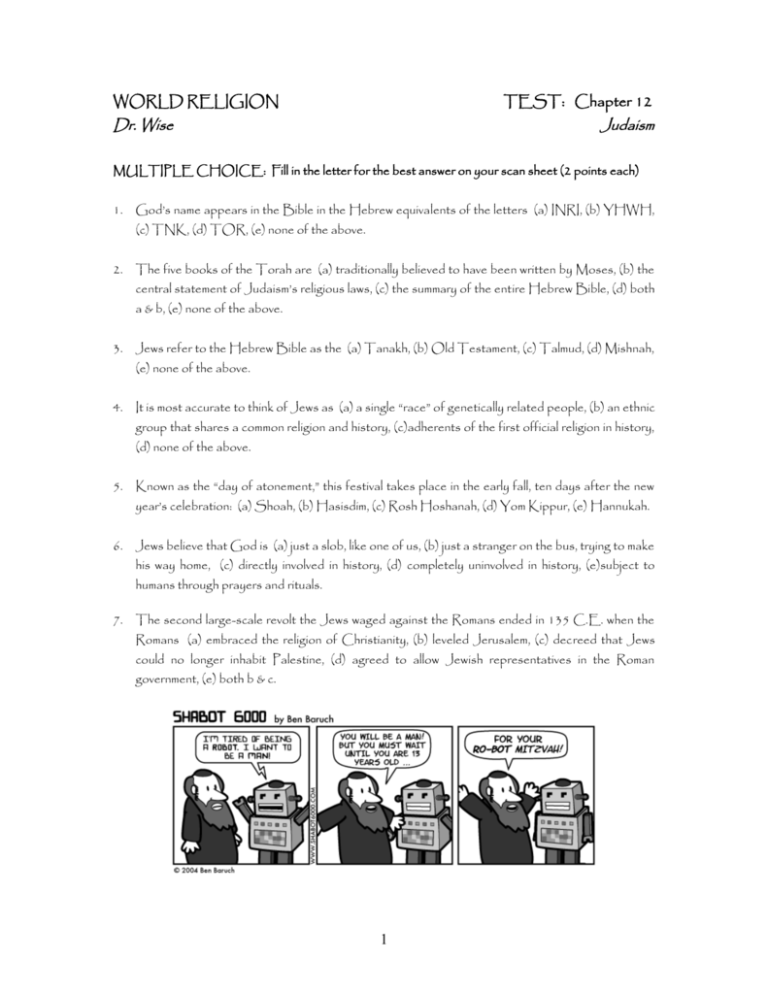
WORLD RELIGION TEST: Chapter 12 Dr. Wise Judaism MULTIPLE CHOICE: Fill in the letter for the best answer on your scan sheet (2 points each) 1. God’s name appears in the Bible in the Hebrew equivalents of the letters (a) INRI, (b) YHWH, (c) TNK, (d) TOR, (e) none of the above. 2. The five books of the Torah are (a) traditionally believed to have been written by Moses, (b) the central statement of Judaism’s religious laws, (c) the summary of the entire Hebrew Bible, (d) both a & b, (e) none of the above. 3. Jews refer to the Hebrew Bible as the (a) Tanakh, (b) Old Testament, (c) Talmud, (d) Mishnah, (e) none of the above. 4. It is most accurate to think of Jews as (a) a single “race” of genetically related people, (b) an ethnic group that shares a common religion and history, (c)adherents of the first official religion in history, (d) none of the above. 5. Known as the “day of atonement,” this festival takes place in the early fall, ten days after the new year’s celebration: (a) Shoah, (b) Hasisdim, (c) Rosh Hoshanah, (d) Yom Kippur, (e) Hannukah. 6. Jews believe that God is (a) just a slob, like one of us, (b) just a stranger on the bus, trying to make his way home, (c) directly involved in history, (d) completely uninvolved in history, (e)subject to humans through prayers and rituals. 7. The second large-scale revolt the Jews waged against the Romans ended in 135 C.E. when the Romans (a) embraced the religion of Christianity, (b) leveled Jerusalem, (c) decreed that Jews could no longer inhabit Palestine, (d) agreed to allow Jewish representatives in the Roman government, (e) both b & c. 1 8. Israel was granted statehood in (a) 1933, (b) 1941, (c) 1948, (d) 1958, (e) 1989. 9. Judaism’s basic theological statement—what they believe about God—is summed up in the prayer known as the (a) Bimah, (b) Shema, (c) Mishnah, (d) Shkinah, (e) none of the above. 10. The word Torah may mean or refer to (a) “instruction,” (b) “the will of God revealed to humankind,” (c) “law”, (d)the first five books of the Hebrew Bible, (e) all of the above. 11. This writing contains the collected teachings of about four centuries of rabbis: (a) Tanakh, (b)Talmud, (c) Mishnah, (d) N’vim, (e) K’tuvim. 12. The festival occurring in the early fall in commemoration of the new year: (a) Passover, (b) Yom Kippur, (c) Hannukah, (d) Tabernacles, (e) none of the above. 13. The form of Judaism known as Hasidism (a) arose in eastern Europe in the 18th century, (b)emphasizes mysticism and a personal relationship with God, (c) focuses on having a close-knit community, (d) follows the leadership of the zaddik or charismatic holy man, (e) all of the above. 14. The Eight-day festival celebrated in early Spring that commemorates the Exodus of the Jews from Egypt: (a) Kosher Spring Break, (b) Hannukah, (c) Tabernacles, (d) Rosh Hoshanah, (e)Passover. 15. The situation of the Jews living away from their own homeland while maintaining their religious identity is known as the (a) Exodus, (b) Diaspora, (c) Dispersion, (d) both a & b, (e) both b & c. 16. The Jews often refer to the Holocaust as the “Shoah”, a word which means (a) “mass destruction,” (b) “burnt offering,” (c) “separation,” (d) “suffering,” (e) none of the above. 17. The attitude that being Jewish and being completely involved in society are compatible is most typical of (a) Reformed Jews, (b) Orthodox Jews, (c) Conservative Jews, (d) b & c, (e) none of the above. 18. The movement that was committed to the re-establishment of a Jewish homeland was known as (a)Hasidism, (b) Palestrina, (c) Judaica, (d) Hashemism, (e) Zionism. 19. According to the Mishnah, what is it that sustains the world? (a) the Torah, (b) deeds of lovingkindness, (c) Temple service, or worship, (d) all of the above, (e) none of the above. 20. The Jewish prayer of mourning is known as the (a) Oy-veh, (b) Kabbalah, (c) Kipah, (d) Kaddish, (e) Huppah. 21. In the Talmud, rabbis comment on small portions of (a) pork, in order to demonstrate why this is a forbidden food, (b) Tanakh, (c) the Gospel, (d) the Mishnah, (e) both b & c. 2 22. What are the major aspects of the Sabbath? (a) wild orgies, (b) rest, (c) worship, (d) recitation of the Tanakh, (e) both b & c. 23. At a Jewish wedding, the bride and groom stand together under a canopy called the (a)tabernacle, (b) huppah, (c) kaddish, (d) zaddik, (e) kippah. TRUE OR FALSE: Fill in (a) for “true” and (b) for “false” (2 points each) 24. Judaism places great emphasis on group identity. 25. Observant Jews avoid speaking God’s name, out of reverence. 26. The Mishnah is based directly on the Talmud. 27. The Pharisees focused on the Torah rather than on the Temple. 28. Judaism became the official religion of the Roman Empire in the fourth century. 29. Jews lived in relative peace and prosperity in Muslim Spain and Poland during the medieval period. 30. Arguments in the Talmud are supported by the Jewish Scriptures/bible. 31. The Kabbalah does not observe the basic forms of Jewish practice, such as keeping the commandments of the Torah. 32. Large Hasidic communities still exist today in North America and elsewhere. 33. Fewer than half of the world’s Jews live in Israel. 34. Similar to the Amish, Orthodox Jews reject all aspects of modernity. 35. In Judaism, males alone are required to wear certain ritual accessories during prayer. 3 36. The Sabbath, for all but some reform Jews, begins at sunset on Saturday and lasts until sunset on Sunday. 37. With only about 14 million adherents worldwide, Judaism is among the smallest of the world’s major religions. 38. In reference to the Jews, the term covenant refers to the agreement established long ago between God and the ancient Israelites. 39. The Pentateuch is the first five books of the Bible. 40. The Torah is traditionally thought to contain 613 laws. 41. The literal meaning of the word prophet is “one who foretells future events.” 42. Judaism’s most important and solemn holy day is Yom Kippur. 43. The term bar mitzvah means literally “one born into the covenant.” 44. In Reformed Judaism, which stresses a strict reform and return to the observance of Torah, worship is always in the Hebrew language. 45. During a Jewish wedding, the groom breaks a wine glass with his foot, symbolizing the fate of his wife should she disobey his commands. 46. Every synagogue contains a scroll of the five books of the Torah. 47. The centers of Jewish worship are the home and the synagogue. 48. The prayer of the Kabbalah, recited daily by Jews, begins: “Hear O Israel! The Lord is our God, the Lord alone.” 49. Material taught by the great rabbis of antiquity is known as the “oral Torah”. 50. The bar-mitzvah marks the male’s becoming a fully responsible member of the Jewish community. 4
